Gunter Van Craen - CDIO at Bekaert - Embracing Digital Transformation
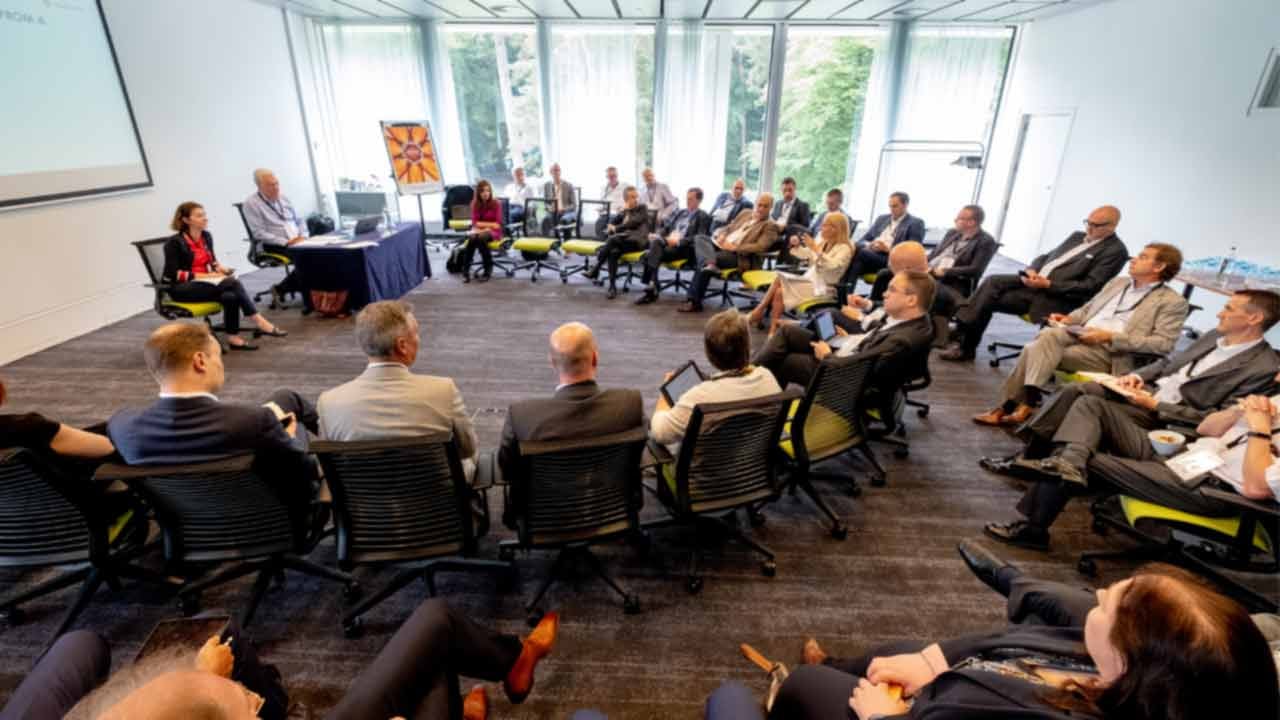
Find out more:
.png)
Poland 5-12-25 Invitation Only Physical Polish
Liderzy biznesowi pokładają ogromne nadzieje w agentach AI, widząc w nich szansę na zbudowanie przewagi konkurencyjnej. Rzadko jednak pada zasadnicze pytanie: czy cyfrowy fundament organizacji – dane, integracje, systemy – jest na to gotowy? Czy obecna strategia integracji wspiera ambicje biznesowe, czy je spowalnia? Podczas naszego biznesowego śniadania CIONET, organizowanego we współpracy z Digia (Finlandia) i Savangard, przyjrzymy się trendom, które dziś definiują architekturę i integracje w Europie i w Polsce. W gronie ok. 20 liderów IT porozmawiamy m.in. o tym: Czy strategia integracji danych i aplikacji powinna uwzględniać przyszłe zastosowania AI? Jak przekształcić kluczowe dane w powtarzalne „data products”, które przyspieszają dostarczanie wartości biznesowej? W jakim kierunku ewoluują platformy integracyjne – iPaaS i API Management? Cloudification - jakie lekcje wynoszą firmy, które przeszły takie transformacje z legacy do nowoczesnej integracji w chmurze? Jak zorganizować „integration core team”, który wzmacnia rozproszone i coraz bardziej niezależne zespoły technologiczne? Spotkanie odbędzie się w kameralnej atmosferze Centrum Praskiego Koneser (CHPTR) i będzie prowadzone w formule dyskusyjnej – z myślą o praktykach zajmujących się modernizacją architektury, integracją systemów i przygotowaniem IT na kolejne lata.
Read More.png)
Poland 8-12-25 Invitation Only Physical Polish
W wielu firmach monitoring wydaje się działać poprawnie, dopóki nie spojrzymy na to, czego nie widać: luki między narzędziami, brak wspólnego obrazu usług, opóźnienia między zdarzeniem a decyzją. W takiej sytuacji trudno wcześnie wykryć degradację, oszacować wpływ incydentów na klientów czy przewidzieć ryzyka, które uderzają w biznes, zanim IT zdąży zareagować. Podczas CIONET Executive Roundtable, którego partnerem jest Spluk, porozmawiamy o tym, ile organizacje tracą na rozproszonym monitoringu i jak wiele można zyskać, gdy staje się on spójnym systemem, a nie zbiorem narzędzi. Zastanowimy się, jak połączyć dane z aplikacji, infrastruktury i biznesu w jeden obraz, który realnie wspiera szybkość reakcji, stabilność usług i jakość decyzji.
Read More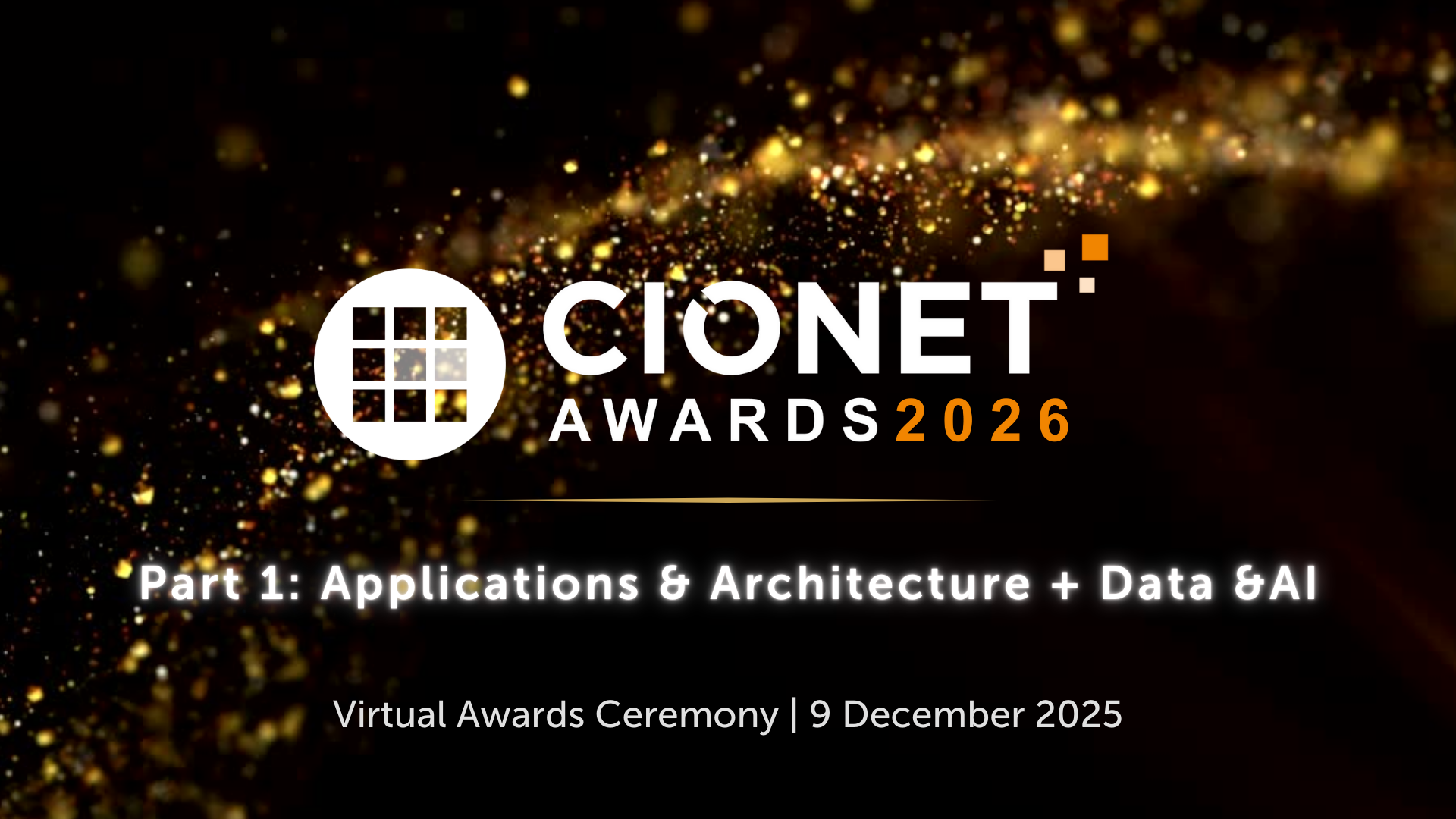
International 9-12-25 Public Virtual english
The CIONET Awards 2026: Part 1, the premier celebration of excellence in digital mission and leadership. During this event the spotlight falls on two of the most critical arenas in modern enterprise: Applications & Architecture and Data & AI. Prepare for a dynamic session where each nominee will present their groundbreaking achievements.
Read More.png)
Brazil 9-12-25 Country Members Physical portuguese
Cerimônia de Premiação CIONET BRASIL 2025.Reconheceremos as Empresas Líderes em Excelência Tecnológica em Projetos e os Líderes Digitais do Ano 2025.Quando?09 de Dezembro de 2025A partir das 18:30Onde?Sheraton São Paulo WTC HotelInscrições online: https://www.cionet.com/pt-br/events/pr%C3%AAmios-cionet-brasil-2025
Read More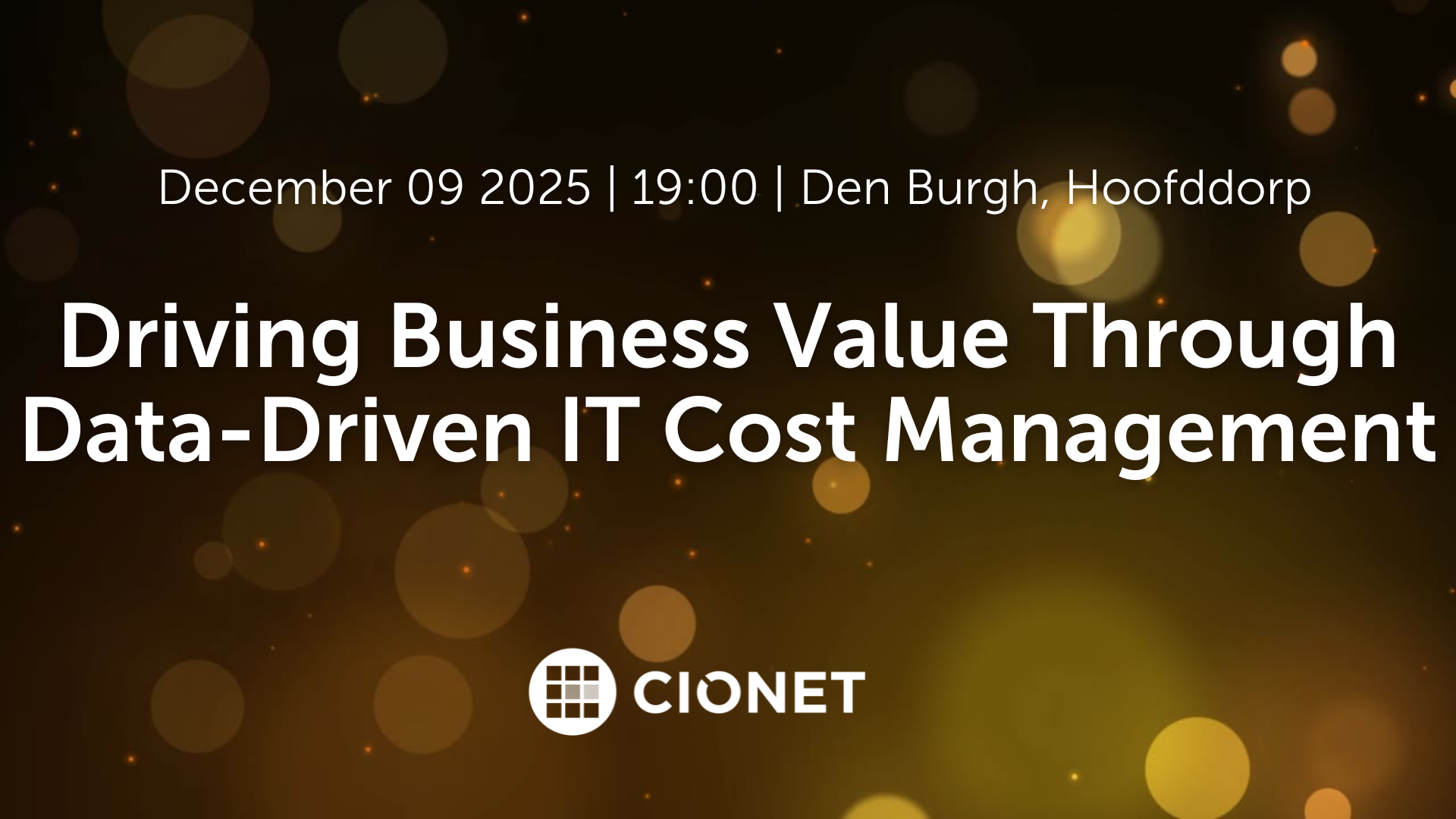
Netherlands 9-12-25 Invitation Only english
At this exclusive CIONET Executive Roundtable, hosted in partnership with It’s Value, we will explore how Technology Business Management (TBM) principles can help CIOs and IT leaders make data-driven financial decisions that drive measurable business value.
Read MoreNetherlands 9-12-25 Invitation Only Physical english
Digital transformation and ongoing economic uncertainty are intensifying the pressure on IT leaders to do more with less. In this environment, gaining precise control over IT costs—while continuing to deliver effective, efficient, and innovative technology operations—is more critical than ever. At this exclusive CIONET Executive Roundtable, hosted in partnership with It’s Value, we will explore how Technology Business Management (TBM) principles can help CIOs and IT leaders make data-driven financial decisions that drive measurable business value. Key Discussion Themes Turning data insights into smarter IT investment decisions Setting priorities for cost optimisation and maximising ROI Quantifying and communicating the business value of IT initiatives Evaluating the principles of FinOps and the implications of public, private, and hybrid cloud environments for cost management Embedding effective change management to drive adoption and alignment Achieving tangible business outcomes from AI initiatives while maintaining fiscal discipline The evening will also feature a fireside chat with Sunil Anand, Global Head of Technology Business Management at National Grid. Sunil will share practical lessons and key milestones, retracing the National Grid cost management journey. This dinner offers a unique opportunity to: Exchange experiences with peers facing similar challenges Gain insights from TBM experts and industry practitioners Reassess your own IT financial strategy in a relaxed, collegial setting Join us for an evening of insight, discussion, and connection—designed to help you strengthen IT’s role as a true business value driver.
Read More.jpg)
Belgium Dec 4, 2025 Invitation Only Physical english
CIONET is committed to highlighting and celebrating female role models in IT, Tech & Digital, creating a leadership programme that empowers and elevates women within the tech industry. This initiative is dedicated to showcasing the achievements and successes of leading women, fostering an environment where female role models are recognised, and their contributions can ignite progress and inspire the next generation of women in IT.
Read More.png)
International Dec 9, 2025 Public Virtual english
The CIONET Awards 2026: Part 1, the premier celebration of excellence in digital mission and leadership. During this event the spotlight falls on two of the most critical arenas in modern enterprise: Applications & Architecture and Data & AI. Prepare for a dynamic session where each nominee will present their groundbreaking achievements.
Read More
Netherlands Dec 9, 2025 Invitation Only Physical english
Digital transformation and ongoing economic uncertainty are intensifying the pressure on IT leaders to do more with less. In this environment, gaining precise control over IT costs—while continuing to deliver effective, efficient, and innovative technology operations—is more critical than ever. At this exclusive CIONET Executive Roundtable, hosted in partnership with It’s Value, we will explore how Technology Business Management (TBM) principles can help CIOs and IT leaders make data-driven financial decisions that drive measurable business value. Key Discussion Themes Turning data insights into smarter IT investment decisions Setting priorities for cost optimisation and maximising ROI Quantifying and communicating the business value of IT initiatives Evaluating the principles of FinOps and the implications of public, private, and hybrid cloud environments for cost management Embedding effective change management to drive adoption and alignment Achieving tangible business outcomes from AI initiatives while maintaining fiscal discipline The evening will also feature a fireside chat with Sunil Anand, Global Head of Technology Business Management at National Grid. Sunil will share practical lessons and key milestones, retracing the National Grid cost management journey. This dinner offers a unique opportunity to: Exchange experiences with peers facing similar challenges Gain insights from TBM experts and industry practitioners Reassess your own IT financial strategy in a relaxed, collegial setting Join us for an evening of insight, discussion, and connection—designed to help you strengthen IT’s role as a true business value driver.
Read More.jpg)
Italy Dec 10, 2025 Invitation Only Physical italian
Questa roundtable esclusiva offrirà a CIO, CISO e Leader di ITOps/Engineering un confronto diretto per individuare le migliori strategie di Innovazione che, attraverso l'observability, ottimizzino il Return of Investment.
Read More.jpg)
Belgium Dec 11, 2025 Country Members Physical english
Imagine being able to monitor, simulate, and optimise an entire city, factory, or supply chain in real time. Next-generation digital twins are making this vision a reality, transforming how we manage and understand complex systems. By creating dynamic virtual replicas of physical assets and processes, digital twins allow organisations to predict issues, optimize performance, and make data-driven decisions with unprecedented accuracy.This event will explore how digital twins are being used across industries to revolutionize the way we operate and maintain large-scale, intricate systems—whether it’s the infrastructure of a smart city, the efficiency of a factory floor, or the resilience of global supply chains.Examples of Digital Twins in Action:Smart Cities: Urban planners can use digital twins to simulate traffic flow, monitor energy usage, or predict the impact of weather events on infrastructure. This enables cities to optimize resources and improve the quality of life for their citizens.Factories of the Future: Manufacturing plants are leveraging digital twins to monitor equipment in real time, prevent downtime, and optimize production lines. With predictive analytics, factories can avoid costly breakdowns and improve overall efficiency.Supply Chain Management: Complex supply chains, spanning continents and industries, can be modeled as digital twins to track shipments, simulate disruptions, and optimize logistics. Businesses can reduce inefficiencies and respond faster to market demands.Key Themes:Real-Time Monitoring and Simulation: How digital twins provide real-time insights into complex systems, allowing for dynamic response and optimization.Predictive Power: Leveraging AI and data analytics, digital twins help organisations predict and mitigate issues before they happen, from equipment failures to supply chain bottlenecks.Scalability Across Ecosystems: Digital twins aren’t limited to individual assets—learn how they can be scaled across entire ecosystems like smart cities or global supply chains for maximum impact.Building Trust and Security: With digital twins handling critical infrastructure and sensitive data, what are the security and governance frameworks needed to ensure trust in these virtual systems?Why You Should Attend:Next-generation digital twins are no longer just a concept—they are revolutionizing industries by offering a new way to manage complexity. Whether you’re looking to optimize a city, factory, or supply chain, this event will provide practical insights into how digital twins can transform your organisation’s operations and drive future innovation.
Read More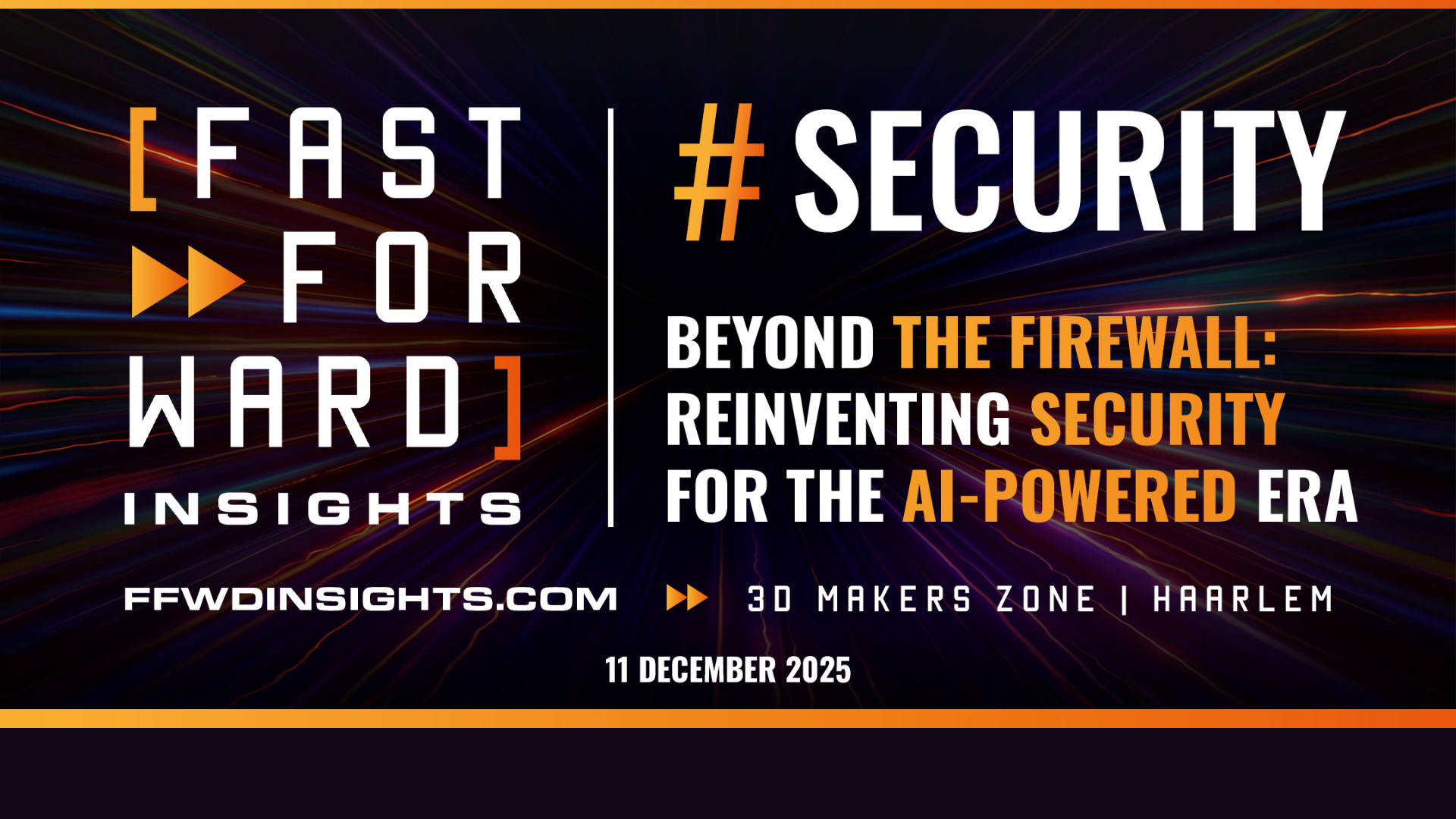
Netherlands Dec 11, 2025 Invitation Only Physical dutch
Navigating tommorrow's threatscape: Cybersecurity insights for digital leaders. Op 28 november in de 3D Makers Zone in Haarlem.
Read More.jpg)
Belgium Dec 4, 2025 Invitation Only Physical english
CIONET is committed to highlighting and celebrating female role models in IT, Tech & Digital, creating a leadership programme that empowers and elevates women within the tech industry. This initiative is dedicated to showcasing the achievements and successes of leading women, fostering an environment where female role models are recognised, and their contributions can ignite progress and inspire the next generation of women in IT.
Read More.png)
International Dec 9, 2025 Public Virtual english
The CIONET Awards 2026: Part 1, the premier celebration of excellence in digital mission and leadership. During this event the spotlight falls on two of the most critical arenas in modern enterprise: Applications & Architecture and Data & AI. Prepare for a dynamic session where each nominee will present their groundbreaking achievements.
Read More
Netherlands Dec 9, 2025 Invitation Only Physical english
Digital transformation and ongoing economic uncertainty are intensifying the pressure on IT leaders to do more with less. In this environment, gaining precise control over IT costs—while continuing to deliver effective, efficient, and innovative technology operations—is more critical than ever. At this exclusive CIONET Executive Roundtable, hosted in partnership with It’s Value, we will explore how Technology Business Management (TBM) principles can help CIOs and IT leaders make data-driven financial decisions that drive measurable business value. Key Discussion Themes Turning data insights into smarter IT investment decisions Setting priorities for cost optimisation and maximising ROI Quantifying and communicating the business value of IT initiatives Evaluating the principles of FinOps and the implications of public, private, and hybrid cloud environments for cost management Embedding effective change management to drive adoption and alignment Achieving tangible business outcomes from AI initiatives while maintaining fiscal discipline The evening will also feature a fireside chat with Sunil Anand, Global Head of Technology Business Management at National Grid. Sunil will share practical lessons and key milestones, retracing the National Grid cost management journey. This dinner offers a unique opportunity to: Exchange experiences with peers facing similar challenges Gain insights from TBM experts and industry practitioners Reassess your own IT financial strategy in a relaxed, collegial setting Join us for an evening of insight, discussion, and connection—designed to help you strengthen IT’s role as a true business value driver.
Read More.jpg)
Italy Dec 10, 2025 Invitation Only Physical italian
Questa roundtable esclusiva offrirà a CIO, CISO e Leader di ITOps/Engineering un confronto diretto per individuare le migliori strategie di Innovazione che, attraverso l'observability, ottimizzino il Return of Investment.
Read More.jpg)
Belgium Dec 11, 2025 Country Members Physical english
Imagine being able to monitor, simulate, and optimise an entire city, factory, or supply chain in real time. Next-generation digital twins are making this vision a reality, transforming how we manage and understand complex systems. By creating dynamic virtual replicas of physical assets and processes, digital twins allow organisations to predict issues, optimize performance, and make data-driven decisions with unprecedented accuracy.This event will explore how digital twins are being used across industries to revolutionize the way we operate and maintain large-scale, intricate systems—whether it’s the infrastructure of a smart city, the efficiency of a factory floor, or the resilience of global supply chains.Examples of Digital Twins in Action:Smart Cities: Urban planners can use digital twins to simulate traffic flow, monitor energy usage, or predict the impact of weather events on infrastructure. This enables cities to optimize resources and improve the quality of life for their citizens.Factories of the Future: Manufacturing plants are leveraging digital twins to monitor equipment in real time, prevent downtime, and optimize production lines. With predictive analytics, factories can avoid costly breakdowns and improve overall efficiency.Supply Chain Management: Complex supply chains, spanning continents and industries, can be modeled as digital twins to track shipments, simulate disruptions, and optimize logistics. Businesses can reduce inefficiencies and respond faster to market demands.Key Themes:Real-Time Monitoring and Simulation: How digital twins provide real-time insights into complex systems, allowing for dynamic response and optimization.Predictive Power: Leveraging AI and data analytics, digital twins help organisations predict and mitigate issues before they happen, from equipment failures to supply chain bottlenecks.Scalability Across Ecosystems: Digital twins aren’t limited to individual assets—learn how they can be scaled across entire ecosystems like smart cities or global supply chains for maximum impact.Building Trust and Security: With digital twins handling critical infrastructure and sensitive data, what are the security and governance frameworks needed to ensure trust in these virtual systems?Why You Should Attend:Next-generation digital twins are no longer just a concept—they are revolutionizing industries by offering a new way to manage complexity. Whether you’re looking to optimize a city, factory, or supply chain, this event will provide practical insights into how digital twins can transform your organisation’s operations and drive future innovation.
Read More
Netherlands Dec 11, 2025 Invitation Only Physical dutch
Navigating tommorrow's threatscape: Cybersecurity insights for digital leaders. Op 28 november in de 3D Makers Zone in Haarlem.
Read MoreVolkswagen supports computer-aided engineering with a modern operating system
To simplify operating system management, Volkswagen migrated from UNIX to Red Hat Enterprise Linux for Workstations. Now close to 1,000 engineers in Volkswagen R&D now use Red Hat Enterprise Linux for computer-aided engineering (CAE) to support the latest professional graphics processing units (GPUs) and access the high volumes of memory.
To simplify operating system management for its research and development (R&D) engineers, Volkswagen migrated from UNIX to Red Hat Enterprise Linux for Workstations, a stable, supported platform for resource- and graphics-intensive workloads, such as aerodynamics analysis and crash test simulations. Close to 1,000 engineers in Volkswagen R&D now use Red Hat Enterprise Linux for computer-aided engineering (CAE) to support the latest professional graphics processing units (GPUs) and access the high volumes of memory needed for powerful processing. Standardizing on Red Hat Enterprise Linux also helps the automaker’s third-party vendors ensure their software is compatible and certified to meet Volkwagen’s security and performance needs.
At German automotive manufacturer Volkswagen, research and development (R&D) engineers rely on computer-aided engineering (CAE) for many of their tasks, from analyzing aerodynamics during vehicle development to simulating the impact of a collision. These tasks require powerful workstations to run analytics and provide graphical outputs.
“CAE replaced pen, pencil, and calculator for engineering calculations. In addition, running physical crash tests with real cars that were very costly was time-consuming, because you had to build a new car for each test. With CAE, you can run a crash simulation on your workstation, then analyze the data to inform design improvements, ” said Gunther Mayer, Integration Specialist, CAE-Integration, R&D, Volkswagen.
In the early days of CAE, Volkswagen’s team of around 300 R&D engineers ran their simulations on a variety of UNIX desktops—including Silicon Graphics (SGI) IRIX, IBM AIX, Oracle Solaris, and HP-UX—as well as CAE products and tools from close to 100 vendors. These vendors used a variety of Linux distributions, making quality control and assurance more difficult.
As simulations became more advanced, however, this complexity affected productivity. Volkswagen sought a solution that would provide more robust workstation capabilities.
“Over time, crash test models have become more detailed. Today, photorealistic simulations show what happens inside the car in very fine detail,” said Mayer. “Good graphics are required and in turn, hardware acceleration and reliability. We needed a 64-bit operating system with enterprise support.”
After exploring potential operating systems, including 64-bit Microsoft Windows, Volkswagen’s R&D engineering team chose Red Hat Enterprise Linux for Workstations, a version optimized for high-performance, graphically intensive workloads like CAE.
“We decided early to standardize on Red Hat Enterprise Linux because it was stable and offered commercial support,” said Mayer. “Security updates were built in, and we could call Red Hat or raise a ticket if there was an issue. It also has a long lifecycle, like many of our automotive applications, so we could easily keep any legacy version up to date for our engineers to run two - or even five-year-old applications if needed.”
Volkswagen migrated 300 workstations, as well as tools and applications, from UNIX to Red Hat Enterprise Linux to support various processes across a range of departments, from crash simulations to computational fluid dynamics (CFD) for aerodynamics testing. In the years since its initial deployment, more than 1,000 engineers in Volkswagen R&D now use Red Hat Enterprise Linux for Workstations.
A Red Hat Technical Account Manager (TAM) provides consistent, ongoing support for the company’s CAE Linux client team, such as collaborative troubleshooting sessions using a screen-sharing approach for complex challenges. “Talking to an expert is far better than learning ourselves through errors. We just explain what we want to do, and our TAM shows us different approaches and their advantages and disadvantages,” said Mayer.
Support for large amounts of RAM was a deciding factor in Volkswagen R&D’s choice of an operating system—and remains important as processing and other needs change. Its engineers needed an operating system that supported not only powerful CPUs from Intel and AMD but also large amounts of memory. The Red Hat Enterprise Linux for Workstations devices that Volkswagen R&D runs today offer a massive 768 GB of RAM.
“We always use the latest and greatest hardware, including the latest professional GPUs,” said Mayer. “Red Hat Enterprise Linux for Workstation can meet the demands of those new components. The 64-bit Windows workstations lacked the memory needed for our simulations’ OpenGL [Open Graphics Library] graphics.”
To ensure compatibility of all of the third-party software products used by its engineers, Volkswagen R&D set up a workgroup with other industry contributors and automotive software providers to standardize on Red Hat Enterprise Linux.
“Because we need reliable, production-ready technology, we now only install software from vendors who have tested and certified on Red Hat Enterprise Linux,” said Mayer. “Many of them were already running in our UNIX environment, so it was fairly easy for them to port their software and work with Red Hat to gain certification. The certification program is important for our R&D work.”
Focusing on a single Linux distribution avoids duplication of efforts to prepare different versions for different vendors, but also makes troubleshooting faster and easier.
“By uniting on one stable, supported Linux distribution, we know we can work together internally and with our vendors to replicate and resolve any issues,” said Oliver Langner, Application Manager, Group IT, Volkswagen.
Initially, Volkswagen’s IT department worried about the security quality of using a Linux distribution, but the R&D team quickly demonstrated how Red Hat Enterprise Linux helped them meet all security compliance requirements.
“Red Hat provides confirmed security patches for any bugs or vulnerabilities that we can apply quickly,” said Mayer. “Then Red Hat Enterprise Linux for Workstations lets us send the IT department a complete list of all of the security patches installed for faster verification.”
The R&D team’s success with Red Hat Enterprise Linux for Workstations has attracted new users at Volkswagen, including software developers who have added various Python tools and packages and Group Innovation, a user group developing artificial intelligence (AI) data models.
Volkswagen continues exploring new versions of the operating system as they are introduced, including some initial migrations from Red Hat Enterprise Linux 7 to version 8 and starting to build a version 9 client image, to take advantage of the latest features and enhancements.
“Going forward, we see the adoption of a unified CAE Linux client based on Red Hat Enterprise Linux for Workstations across other brands within the Volkswagen Group, such as our server department, as well as externally with software vendors,” said Langner.
276 Views 0 Likes Read More

Embark on a culinary journey through the ever-evolving world of digital leadership with our third edition of the CIONET Cookbook: Recipes for Digital Success. Unveiling the intricate trilemma faced by today’s Master Chefs, our trailblazing European CIOs address a challenge at the nexus of customer interests, digital transformation strategies, and IT modernisation. Their secret? Synchronising the gearing between customer, business, and technology to create a frictionless movement through the digital landscape.
The CIONET Cookbook uses the analogy of a five-star restaurant to explain the importance of optimally integrated technology, with the CIO as Master Chef. In order to provide the best service to its customers, a top restaurant must have the right atmosphere, an inviting menu, a well-equipped kitchen, talented and committed front-of-house and kitchen staff and smooth-running processes that ensure an enjoyable experience for diners.
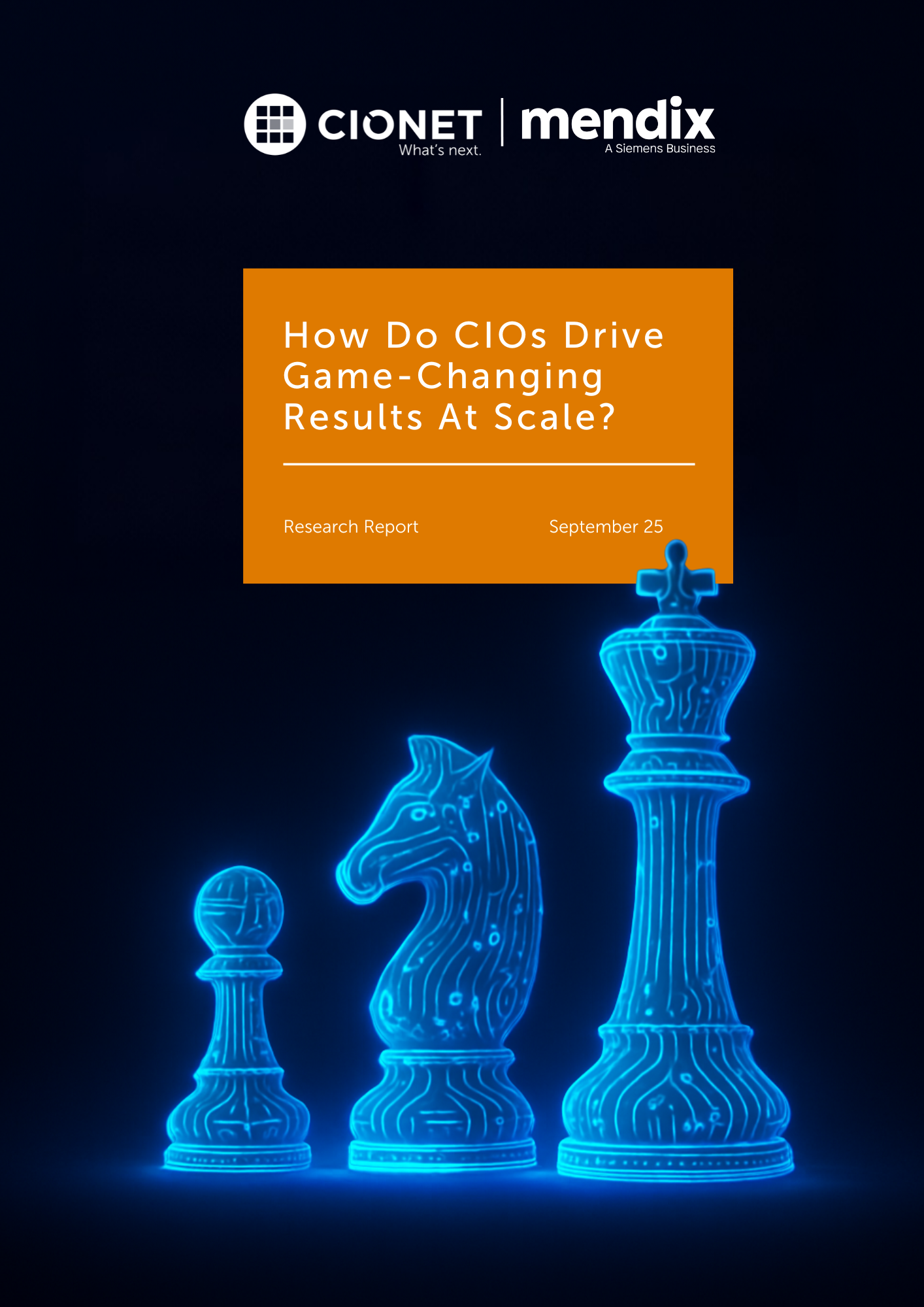
The role of the CIO has evolved from managing systems to shaping outcomes: growth, resilience, and competitive edge are now won or lost in the technology arena. Today ’ s CIOs must balance stability with innovation, control costs while attracting scarce talent, and modernise legacy infrastructure while adopting emerging technologies.
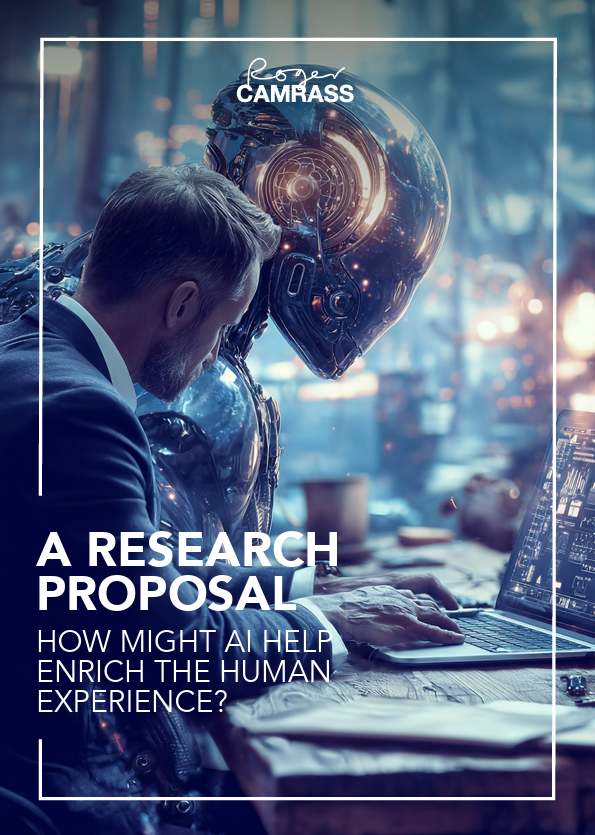
As AI transitions from a specialised tool to an all-pervasive force, understanding its profound implications for our human lives is no longer merely academic but an urgent imperative for social well-being and strategic preparedness.
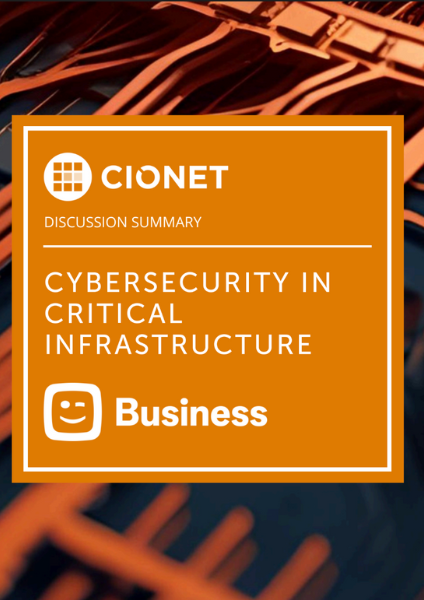
Geopolitical tensions have dominated the headlines for over two years now. In this context, the cyber threat landscape is also evolving rapidly. The protection and security of critical infrastructure – both physical and digital – is becoming increasingly important.
In our new app, our members connect with other digital leaders from around the world to find better solutions to their challenges.
Connect with digital leaders like you
Share ideas, best practices, and new resources
Experience inspiring and thought-provoking content and conversations you can’t find anywhere else
Make better, more well-informed decisions about the topics that are most important to you
.png?width=600&height=600&name=Anna%20Kopp%20(1).png)
Head of IT Germany and Regional Office Lead Munich, Microsoft

IT Director, IT Thinker

Vice president IT & Compliance, VisionaryRCM (A Carlyle Grp Company)
CIONET’s mission is to help IT executives become more at ease and above all more successful in their jobs. So they can do more than just keep up with change but ultimately define it. CIONET opens up a whole new universe of opportunities in IT management.
With the largest membership of corporate digital leaders across Europe, Latin America, US and Australia, CIONET has the expertise and pioneering vision to solve or address any IT management challenge.
From our local and global events, from our publications and research to our executive education programmes, everything we do is aimed at making sure digital leaders maximise their potential.
with digital leaders who share your interests, who face the same challenges, who care about the same topics.
stories, experiences, and ideas around our shared mission.
from our exclusive events, publications and research.
inspiration, thought-provoking conversations, expert perspectives and exclusive first-hand content each and every day
and make better, more well-informed decisions on how to lead your digital business.
your potential. Realise your ambitions.
You can either send us a registered handwritten letter explaining why you'd like to become a member or you can simply talk to us right here!
Would you like to know more about CIONET, membership or partnership opportunities? Do you have feedback or any other question? Send us a message!